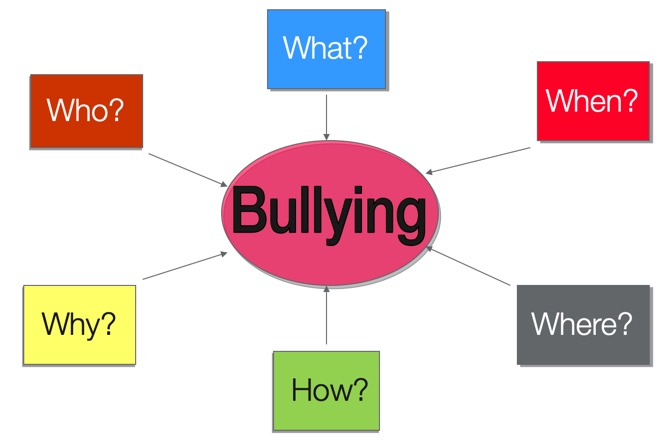Editor's note: This text-based course is an edited transcript of the webinar, Bully Proofing Your Early Childhood Program, in partnership with Region 9 Head Start Association, presented by William DeMeo, PhD.
Learning Outcomes
After this course, participants will be able to:
- Recognize various forms of bullying.
- Identify the effects of bullying behavior on young children.
- Describe practical strategies to prevent and intervene in bullying behavior.
When I do a presentation I always start with an energizer or brain-awaking activity. One of my favorites is called "Just Like Me!" For this activity, I have the young children stand and then I ask them to do things to find out what we have in common and that we are just like each other. As the facilitator or the teacher, I say to the young children, "If you have two ears, remain standing." As you're probably aware, almost all the children are going to be standing. Then I might say, "If you have a nose, remain standing." Again, we're all just alike because everybody has a nose. Then I might move into, "If you have a mother, remain standing." Then I will turn it over to the young children and let them come up with characteristics of how we're just alike. It's a wonderful community-building type of activity and it's a great way to prevent bullying.
Every one of our young children should love their early childhood experience and what we have discovered is bullying takes away that love of that experience. That is why it is so important that we address this topic as early childhood professionals. I'd like to start by giving you a very simple quiz regarding bullying to see how much you know about the particular subject before we begin. Listed below are ten statements. Read each one and reflect on if you think it's true or false.
- Bullies usually don’t do well in schools. TRUE or FALSE
- Bullies have few friends. TRUE or FALSE
- Bullies enjoy having power over others. TRUE or FALSE
- Telling on a bully will only make matters worse. TRUE or FALSE
- Bullies are usually just teasing. TRUE or FALSE
- Only boys are bullies. TRUE or FALSE
- Bullies have low self-esteem. TRUE or FALSE
- Bullies will eventually grow out of this bullying phase. TRUE or FALSE
- There are many forms of bullying. TRUE or FALSE
- All teachers can learn to handle bullying behavior. TRUE or FALSE
Now that you've had time to review and decide if you think each statement is true or false, let me share with you what the research says about each one.
- Bullies usually don’t do well in schools.
- That statement is false. Bullies actually do very, very well in school. They are usually the top students within the educational program.
- Bullies have few friends. TRUE or FALSE
- False, bullies are usually your most popular students.
- Bullies enjoy having power over others.
- True, that is actually one of the criteria regarding bullying behavior.
- Telling on a bully will only make matters worse.
- This statement is either true or false. If you have implemented a bully-proofing program within your early childhood center, then telling on a bully does not make things worse. However, if you have not implemented any strategies, then if a young child tells on a bully, a lot of times things will get worse for them because there's nothing in place to protect them.
- Bullies are usually just teasing.
- False, and we're going to talk about the difference between bullying and teasing so you can determine which is which.
- Only boys are bullies.
- Absolutely false, both boys and girls bully.
- Bullies have low self-esteem.
- False, bullies actually feel very good about themselves and they have a very high level of self-esteem. In fact, some research shows that one of the reasons that young children and individuals get into bullying behavior is because it builds their self-esteem.
- Bullies will eventually grow out of this bullying phase.
- False, it actually can continue through elementary, middle school, high school, and even into adulthood.
- There are many forms of bullying.
- Absolutely true. We are going to talk about direct and indirect bullying. One of the areas of bullying that has a lot of national attention today is cyberbullying.
- All teachers can learn to handle bullying behavior.
- Absolutely true, and that's why you're here today to learn about some strategies to deal with bullying behavior in your programs.
As we were growing up ourselves, we were either the bullies, the individual who was bullied, or the bystander. What I'd like for you to do is to take a few minutes and reflect on your own life. When you were growing up, were you the bully, the individual who was bullied, or a bystander? It is important to know that you can actually be a combination. Please reflect on your own experience with bullying.
I would consider myself to be a bystander. I'm not aware that I was bullying other individuals. At the same time, I was rarely bullied because I was very popular as an individual student and athlete. I am 6'4 and there's not a lot of people who would actually take me on to bully me.
Questions Regarding Bullying Behavior
Figure 1. Questions regarding bullying behavior.
Figure 1 shows the six questions regarding bullying behavior. The first is who are the individuals involved? As I just discussed, there is the bully (the individual who bullies), the young child who is bullied (the one where the bullying behavior is directed towards), and the bystanders. What is bullying behavior? There's actually a very specific definition that we're going to identify in a few minutes, but it's basically aggressive behavior that is purposeful and has the intention to create distress and despair. It occurs multiple times and there's what we call imbalance of power where the bully who bullies the other individual has his power over that particular individual.
When does it occur? It can occur throughout the day within your program. Where does it occur? It can occur in any particular location from in the classroom, outside, the restroom, and transition times. It especially occurs when young children are unsupervised. As you're probably aware one of the most important strategies is the supervision of young children. Let's talk about how it occurs. We're going to talk about the specific types of bullying behavior which we usually refer to as verbal, physical, and nonverbal. These behaviors can be either direct or indirect.
The most interesting and important question is why does it occur? In reviewing the research regarding why young children or children bully and what motivates them, one of the specific reasons is they like to dominate others in a negative way. In addition, they gain satisfaction and pleasure from inflicting injury and suffering on others. Finally, they receive rewards by bullying others, such as prestige, attention, or possessions from others. That's the reason why young children and children are motivated to bully.
Definition of Bullying
The definition that is most widely accepted is bullying is when someone repeatedly and on purpose says or does mean or hurtful things to another person who has a hard time defending himself or herself.
There are some very important connotations related to this definition. First, it is repeated. If a behavior occurs just once it is not considered bullying behavior. It has to be a behavior that is repeated. Second, the intent or the purpose is to be hurtful to somebody else. There needs to be intent and it needs to be associated with an aggressive act. Finally, the person who's being bullied has a hard time defending themselves, meaning that there is an imbalance of power.
Four Markers of Bullying
- A form of aggressive behavior
- Intent to harm
- Repeated over time
- Imbalance of power
As I mentioned, in order to identify bullying behavior there are four criteria. First, it's in the form of aggressive behavior. Second, the intent or purpose is to be hurtful or to create harm. Third, it needs to be repeated. Last, there has to be an imbalance of power. What do I mean by an imbalance of power? This could be numbers such as five young children to one or physical stature where a child is bigger and stronger than the other particular young child. It could also be status, such as a very popular child and a child who is not popular. There are a lot of different ways to describe the imbalance of power.
Reflect
I'd like for you to reflect for a few minutes on behaviors associated with bullying that you have observed in your classroom or home setting. You might want to write them down as we'll be talking more about them as we move on.
Now that you've listed the behaviors, let's see how or where they fit into our bullying spectrum.
Types of Bullying
- Physical
- Verbal
- Nonverbal
- Direct
- Indirect
As I mentioned, there are three types of bullying behavior: verbal, physical, and nonverbal. In addition to that, these behaviors can either be direct or indirect. Indirect behaviors are more difficult to identify than direct bullying behaviors. Let me give you some specific examples of each category.
Physical
Direct Bullying
- Hitting
- Kicking
- Shoving
- Spitting
Indirect Bullying
- Getting Another Person to Assault Someone
When we refer to direct bullying physical behaviors we're talking about hitting, kicking, shoving, and spitting. Indirect bullying physical behaviors occur when the individual gets somebody else to assault the other child.
Verbal
Direct Bullying
- Taunting
- Racial Slurs
- Verbal or Sexual Harassment
Indirect Bullying
- Spreading Rumors
Direct verbal bullying behaviors include taunting, using racial slurs, and verbally or sexually harassing others. Indirect verbal bullying behaviors, which is something that is very popular with children, includes spreading rumors.
Non-Verbal
Direct Bullying
- Threatening
- Obscene Gestures
Indirect Bullying
- Deliberate Exclusion from a Group or Activity
Direct, nonverbal bullying behavior includes threatening or using your body to physically threaten somebody else or using obscene gestures. Indirect nonverbal bullying behavior, which I have discovered is very popular even with young children, is deliberate exclusion from a group or activity. For example, when a child says, "You are not my friend" or, "You cannot play with us" or, "You cannot sit here." This is a very common behavior we see with young children.
Distinguishing Bullying From Common Behaviors
People ask all the time, how do you distinguish bullying from common behaviors such as rough-and-tumble play, fighting, teasing, harassment, and taunting? An attorney and I put together a list of how to differentiate bullying from these other common behaviors we see with young children.
Teasing
- Teaser and person teased easily swap roles
- Innocent in motive
- Not intended to hurt the other person
- Is discontinued when person teased becomes upset or objects to the teasing
Let's begin with teasing. The difference between bullying and teasing is there's not that imbalance of power. Usually, when a child teases, the other child teases back and forth, and there is a give and take between the young children. In general, it is innocent in motive. It's not intended to hurt the other person, and if it does get to the point where it is hurtful, the teasing usually ends and it stops.
Taunting
- Imbalance of power
- Intended to harm
- Sinister in motive
- Involves humiliating, cruel, demeaning comments disguised as jokes
- Continues especially when targeted kid becomes distressed or objects
If you ever watch pro football or college football taunting is a huge concern because there are now penalties they assess for players who taunt other players. This is something that even the NFL and college football are attempting to address. With taunting, there's that imbalance of power. When you see taunting in a football game the particular player stands over the other players and there's this imbalance of power in that I can take you on and kick your butt. Second, the intention is to create harm. It can involve humiliating, cruel, demeaning comments disguised as jokes, and continues especially when targeted children become distressed or object. That's the ongoing, repeated behavior that we talk about which indicates taunting can and will be considered a bullying behavior.
Rough Play vs. Bullying
- Involves physical aggression
- Peers have a relationship
- Intention is to have fun, not to provoke or intimidate
- Facial expressions reflect enjoyment
- Can be repeated due to the relationship
- No or little interest of curious bystanders
Rough play is a very typical concern from early childhood professionals. Is rough play considered bullying behavior? When you look at the criteria for rough play you see that it does involve physical aggression, but the difference is that the peers have a relationship. Again you'll see a give and take. The intent is to have fun. It is not to provoke or intimidate as far as aggression. In addition, we usually notice that kids have an enjoyable facial expression when they engage in rough play.
Rough play can be repeated, but there is usually no interest by the bystanders. Another aspect of bullying behavior is that it usually has bystander input. Bullying behavior does not occur in a vacuum between two children. There are usually other children involved who are considered to be bystanders. Even though rough play is a concern by early childhood professionals, it is not considered bullying behavior.
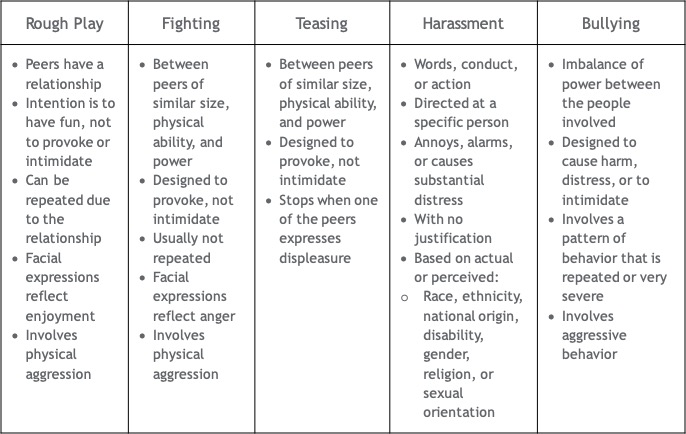
Figure 2. Behavior Analysis Chart.
Figure 2 shows a chart that was developed by my attorney friend and me. We've already talked about rough play and teasing. Let's talk about fighting, which is not considered bullying behavior. One reason for that is because there's not an imbalance of power. If two children get into fights, they are usually similar in size, ability, and power. In addition, fighting is not a repeated behavior. Fighting usually occurs once and usually does not occur again. Even though it is considered an aggressive behavior, it is not considered bullying.
The last thing we'll talk about in this figure is harassment. Thinking back to the definition of bullying, harassment would be considered a bullying behavior if it occurs over and over again. In other words, the behavior is repeated. Hopefully, figure 2 will help you differentiate between bullying behavior and other common behaviors that you see in young children. The one thing that all kids who are bullied have in common is that they were targeted by a bully.
Bullying Scenario
Here's a scenario so you can identify and differentiate bullying behavior.
Children are outside during outdoor play. A group of three boys is off playing by themselves. Another boy, Carl, approaches them and asks if he can play with them. One of the three boys says that they have formed a club and since Carl is not a member he cannot play. Carl asks about the club and the boy says that Carl cannot join the club. The boy says it is the "cool" club and Carl is not cool enough to be in the club. Carl keeps persisting, saying he wants to play and asking how he can get into the club. Finally, the same boy says that if Carl smears dirt on his face they will let him in the club. Carl points out that none of the other boys have dirt on their faces. The boys reply that it does not matter. If Carl wants to be in the club, that is what he needs to do.
Based on what you know about bullying behavior and the criteria, is this bullying behavior? The correct answer is yes, it meets the criteria. First, it's exclusion because the other children excluded Carl from joining their club. Second, in addition to exclusion, they were going to demean and humiliate him by having him put dirt on his face. There's intent and there's also the indication of signs of aggressive behavior. What about power or imbalance? There were three boys to one. That indicates an imbalance of power. Last, is it repeated? Usually, the repetition of bullying behavior is the most difficult to identify because you have to see it over time. In this scenario, there's a very keyword. It says, "Carl keeps persisting." Persistence meaning ongoing, which would indicate a repeated type of behavior. By the criteria, this would be bullying behavior.
As you can see, it's not very easy to identify bullying behavior, especially among young children. Anybody can be a victim of bullying. Interestingly, President Obama said that as he was growing up he was bullied. Do you know why President Obama was bullied? He indicated he was bullied because of two things. One thing children would make fun of was his ears. The other was his skin color. In the African-American community, it has to do with skin color. His skin color happens to be light and for some apparent reason, there was bullying behavior related to his light skin color. Anybody can be the victim of bullying behavior, even the President of the United States.
Warning Signs - Toddler and Preschool
- Has many temper tantrums in a single day, or several lasting more than 15 minutes, and often cannot be calmed by parents, family members, or other caregivers
- Has many aggressive outbursts, often for no reason
- Is extremely active, impulsive, and fearless
- Consistently refuses to follow directions and listen to adults
- Does not seem attached to parents
- Frequently watches violence on television, engages in play that has violent themes, or is cruel toward other children
There are some warning signs to be aware of in young children who may have been bullied or who might be the bully. It's important to remember that these particular warning signs could be an indication of other things, such as trauma or physical or sexual abuse. We, as early childhood professionals, need to be detectives and investigators to determine what is the root cause of that particular behavior.
One behavior you might see is a temper tantrum or many temper tantrums in the course of a day. These temper tantrums might last more than 15 minutes and even the caregiver, yourself, or parents are not able to calm the child. The child may have many aggressive outbursts for no apparent reason. The child might fly off the handle all of a sudden and have explosive behavior for no apparent reason. The child can be extremely active, impulsive, and fearless, more than the other young children within your program.
The next three are more indicators of a child who might actually engage in bullying behavior. The child consistently refuses to follow directions and listen to adults. The child does not seem to be attached to his or her parents, frequently watches violence on television, and/or engages in play that has violent themes or is cruel towards other children. Precursors to bullying behavior are very easy to identify and observe in our early childhood programs, especially during dramatic playtime and how the child associates with materials and others.
Bullying - Prevention and Intervention
Now that we have a good indication of what bullying is and how to identify it, let's talk about what we can do. First, any successful bullying intervention and prevention program needs to be based on evidence-based practices meaning that the research says that these strategies work. Everything I'm going to be discussing is based on research. We know these particular strategies are effective. Second, it's got to be comprehensive. It needs to not only address the child who has been bullied, but also the bully and the bystanders. In addition, we like to have that comprehensive component of working with parents, because parents are very concerned about this topic and subject. Last, it's got to be systematic, meaning that there's a series of interventions that if you try this and it's not effective, then we go to the next level of intervention.
The Five Phases of Implementation
- Awareness
- Commitment
- Capacity
- Implementation
- Evaluation
There are five phases of implementation of a successful program. First of all, there's got to be awareness. I know because you are here today, you're aware of bullying behavior. Second, there needs to be a commitment. You need to be motivated, and I'm assuming you are motivated because you are completing an hour-long course on bullying behavior. Capacity is extremely important. Hopefully, after today, you will have some tools and strategies to deal with this particular behavior in your program. Once you have those tools and strategies, you need to implement, and then most importantly, you need to evaluate to see if the program has been effective.
We have discovered that young children who are bullied face a lot of social-emotional issues. They feel alone. They feel hurt. They feel depressed. In addition, we've also discovered they have lower self-esteem. They don't want to come to school or their program because of bullying behavior. They have temper tantrums and fits when they have to come to daycare or an early childhood program. Some of them will actually have psychosomatic complaints, such as illnesses that may or may not be there. In addition to that, we've discovered they begin to do poorly within their program. They begin to withdraw within themselves. They don't interact with peers and even their pre-academic skills begin to digress.
In addition to that, we also know that there are some concerns with the student or young child who is the bully, especially regarding these behaviors and their future. They get into frequent fights. If they're getting into fights, they might get injured. As they grow up, they engage in stealing and vandalizing property, have a higher risk of drinking alcohol, smoking, and using drugs. They become truant and drop out of school. They perceive school to be a negative place and they will even begin to carry weapons. We're not only concerned about the child who is bullied but also the bully themselves, regarding longterm outcomes.
Things Needed for Bullying to Occur
- Bully
- Victim
- Unsupervised Location
- Bystanders
- Followers
- Supporters
- Passive Supporters
- Disengaged Onlookers
- Possible Defenders
- Defenders
As I mentioned, four things are needed for bullying behavior to occur. One is the bully. You also have the child who is bullied or the victim. An unsupervised location is also needed for bullying to occur. We discovered that when adults are around and supervising, there's less chance of bullying behavior to occur. Last and most importantly, we need the bystanders for bullying to occur. The bystanders are what fuels the bullying behavior.
We've discovered in research that there are actually a number of different bystanders who may be involved. First, there are the followers of the bully. They take an active part in the bullying behavior. In other words, they add on, but they do not actually start it. Then after the followers, there are the supporters. They support the bully and the bullying behavior, but they do not take an active part. We also have what we call the passive supporters. They like the bullying behavior, but they do not display open support for it. Then we have the disengaged onlookers, and finally, we have what we refer to as possible defenders. They dislike the bullying behavior and think they ought to help, but they don't know what to do. The last group of bystanders is children who will be the defenders. They dislike the bullying behavior and they're going to help the other particular student who is bullied. Those are the possible bystanders who may be involved in the bullying situation.
Supervision is Key
Movement - Interaction - Scan (MIS)
As I said, supervision is key. One particular technique and strategy taken from Positive Behavioral Interventions and Support is something called active supervision, the MIS strategy. MIS stands for Movement, Interaction, and Scan. For example, if you ever go to the large water parks, you'll notice the lifeguards now move their heads up and down as they're watching the pool. Basically, they are scanning the entire dimensions of the pool to make sure all of their swimmers are safe. I'm not saying you need to go to that level of scanning, but we need to be aware of what is occurring within our particular programs.
For example, I was observing a program and the early childhood professional was working with a young child and she had her back to the rest of the class. She was not able to scan to see what disruptive behavior might have been occurring. It's very important to put yourself in a position where you can scan the entire classroom or playground to make sure you know what your young children are doing.
It's also very important that we move. Proximity is a wonderful preventative technique regarding bullying behavior. Last is interaction, either verbal or nonverbal interaction with a young child to let them know that you're in touch and you're connected to them. As I said, supervision is the key to prevention.
Four Antidotes to Bullying
- Strong sense of self
- Being a friend
- Having at least one good friend
- Being able to successfully get into a group
In addition to supervision, how do we deal with bullying behavior? There are four antidotes that can also be referred to as resiliency or protective factors. By building these protective factors in young children it's going to help prevent bullying and help them to deal with bullying behavior. The first is referred to as having a strong sense of self, positive self-concept, or positive self-esteem. There are a number of ways that you can do that within your early childhood program.
First is what we call, what is in a name? For every letter of the child's name, we give them a positive attribute or characteristic. For example, my name is Bill. My positive characteristics are brilliant, intelligent, likable, and loveable.
B - brilliant
I - intelligent
L - likable
L - loveable
Figure 3. Name with positive attributes.
Be creative when you give them these characteristics. Every time they hear and see their name with these particular characteristics, it rebuilds their self-esteem. This is also a wonderful activity to do with parents. When parents bring their young children we have the child's first and last name written vertically as seen in figure 3. Then we have the parents fill in the characteristics for each of the letters of their names. This gives us a quick indication of the relationship between that parent and child, and more importantly, it is a great parent engagement activity.
In addition to that, we use a lot of affirmations. There are a lot of great books on affirmations. One that I like is called All That I Am.
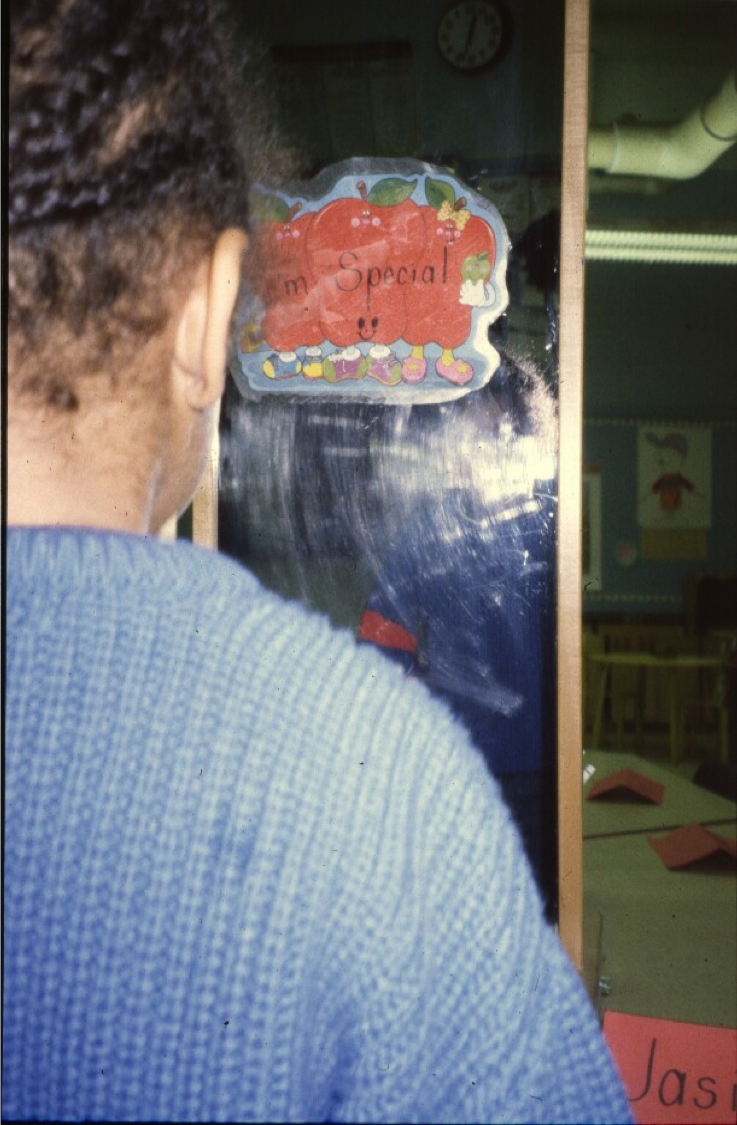
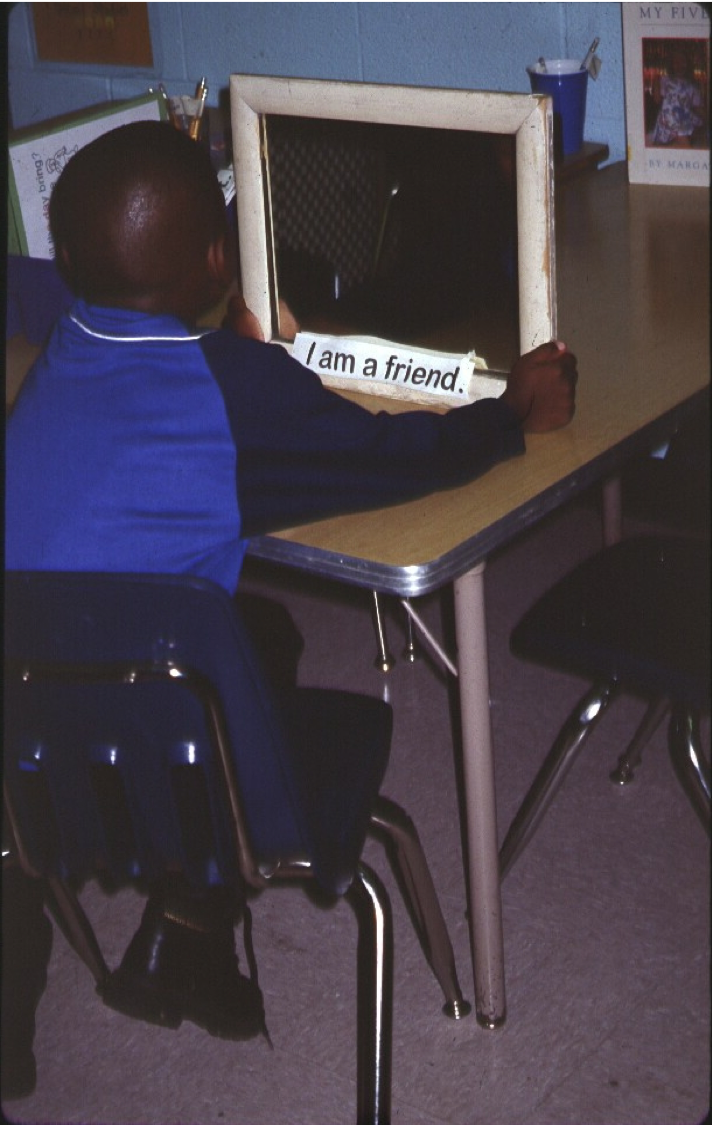 .
. 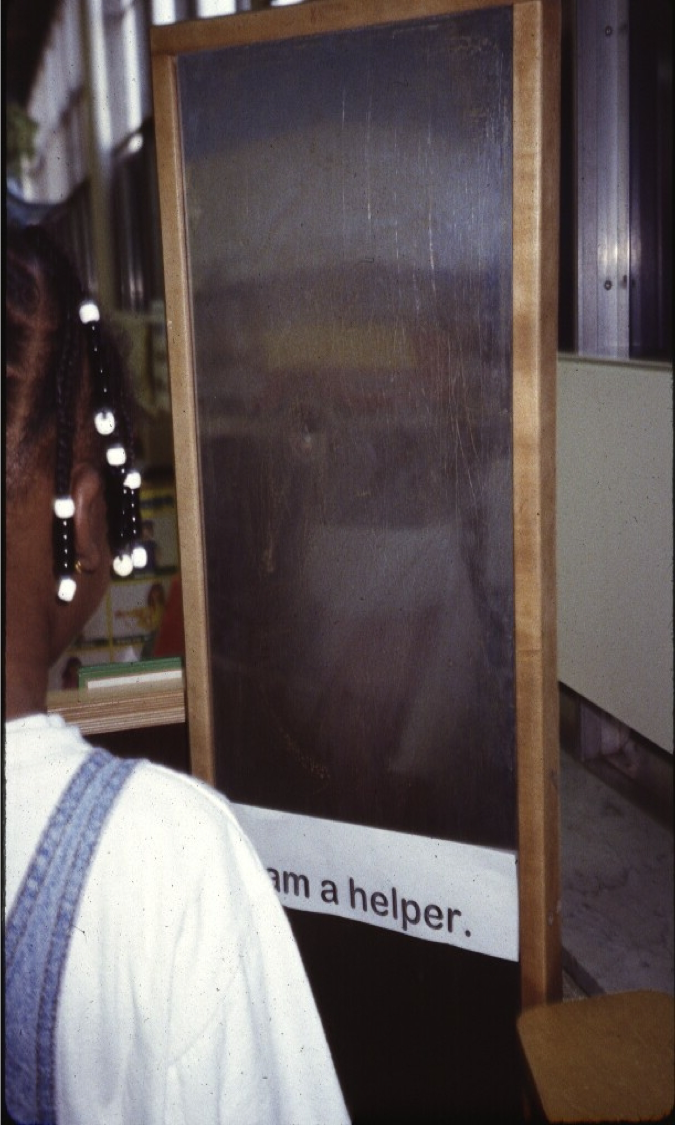
Figure 4. Examples of Mirror Therapy.
Figure 4 shows examples of mirror therapy where we write down positive affirmations, such as "I am special," "I am a friend," or "I am a helper" and place them on the mirror. The young child looks into the mirror, sees their reflection and that positive affirmation, and reflects back into them. You can use all kinds of different affirmations with mirror therapy.
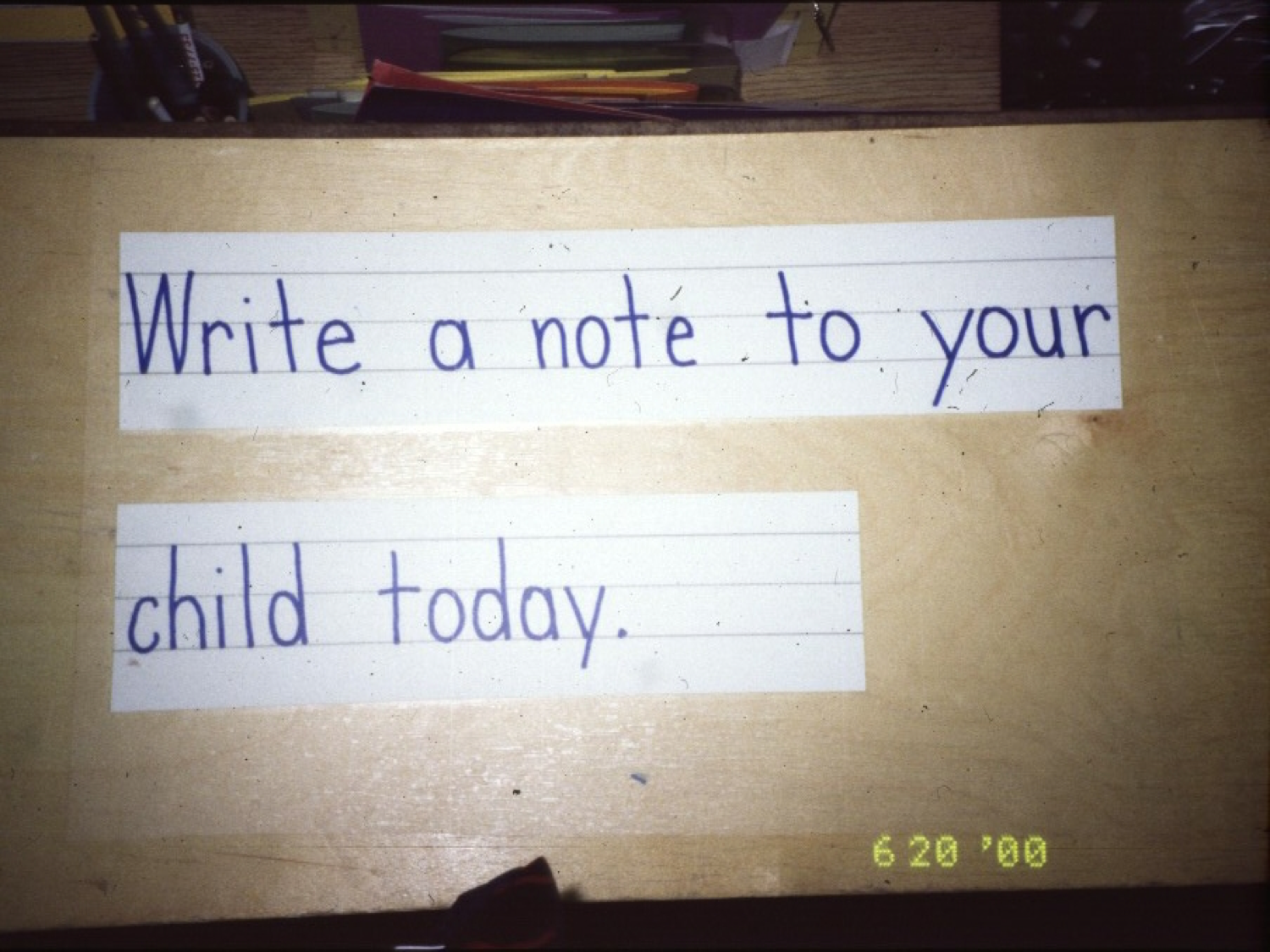

Figure 5. Positive notes in mailbox.
Another thing we do is positive notes in our mailbox, as seen in figure 5. When parents drop off their young children we have them write a positive note to their child, put it into our mailbox, and later our postmaster delivers the mail. When the child gets their letter from their parent they are excited about reading. We encourage literacy at the same time we give the child a positive affirmation through the positive note.
The other indicators or antidotes of bullying all have to do with friendships. These include being a friend, having at least one good friend, and being able to successfully get into a group. These are all protective factors that prevent bullying behavior.
Why are social skills important?
Research shows that successful peer interactions lead to better pre-academic and language skills. In addition, having friends reduces challenging behavior and mental health issues. It also predicts good physical health, continuing friendships, and better employment outcomes in the future. That's why these social skills are so important regarding young children and as protective factors against bullying.
Sociograms

Figure 6. Sociogram.
One of the things that we use to indicate a visual representation of the relationships within our program is sociograms, which have been around for a number of years. We have a child pick two of their friends who they want to play with and then we graph those relationships. As you look at my sociogram in figure 6, what can you tell about child E? Child E happens to be the most popular child in the program. Everybody wants to associate with and play with this child. Now look at child A. What can you tell about child A? Even though child A picked two friends (D and E), nobody picked him. Child A is a child we might need to provide some extra support to and help him develop some of these social skills that are crucial as a protective factor.
Prevention
- Reexamine your own beliefs about bullying
- Take bullying seriously
- Encourage empathy
- Teach bullying prevention strategies to all children
- Provide opportunities for children to learn and practice the qualities and skills that can protect them from bullying
- Encourage children to talk about and report bullying
- Develop strong connections with the children in your care
One of the concerns is that some people believe bullying behavior does not exist. It's very important to reexamine your own beliefs about bullying. I've heard educators say, "They just need to get tough," or "They need to suck it up," or "They need to develop a second skin." That totally goes against the bullying prevention and intervention philosophy. We need to take it seriously. It is an issue and it needs to be addressed. It is definitely a precursor within our early childhood programs.
One of the opposite positive behaviors of bullying is empathy. We've discovered that when young children develop empathy, they are more likely not to engage in bullying behavior because it happens to be the opposite of that destructive type of bullying behavior. Here are some examples of scripts you can use to develop empathy.
- “Your body is going like this.”
- “Your face is telling me___.”
- “You seem_____. Something happened?”
- “You wanted____.”
- “You were hoping_____.”
Your body is going like this. You're telling me that you're not happy. Your face is telling me ___. You seem to be upset, something must have happened. You wanted to ride the tricycle, but somebody else was on it and you seem to be angry about it. You were hoping to be first in line and you appear to be mad. Using these types of scripts helps in developing empathy with young children.
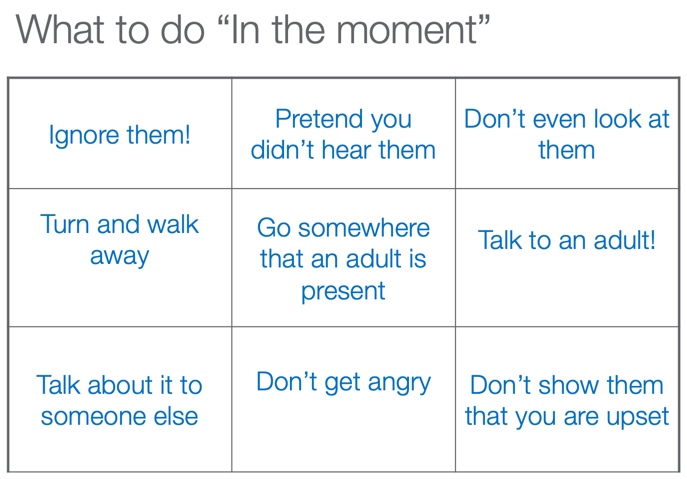
Figure 7. What to do "in the moment."
All young children can be taught strategies to prevent bullying behavior. Figure 7 shows some specific strategies that young children can be taught. Most of them have to do with ignoring and that is the key. The problem is that for young children, ignoring is a very difficult concept and it has to be taught. One of the ways that we do this is from a book called Skillstreaming, where they talk about the way to ignore is to actually get up, turn your back to the person, and walk away. This is a skill that can be practiced in developing ignoring behavior. Another strategy is to pretend you didn't hear them. If they make a comment that is sarcastic and it's meant to hurt, pretend you did not hear them. Don't even establish eye contact with them. As I mentioned, turn and walk away.
The other particular strategy to deal with preventing bullying behavior is getting the adult involved, going somewhere that an adult is present, talking to an adult, or talking about it to someone else. Try to keep your emotions in check, because when you begin to escalate the bullying behavior will continue and escalate as well. Don't show them that you are upset or that they are getting to you, because that's the reaction they want.
It's very important to give young children the opportunity to practice these specific skills that we just talked about to protect them from bullying behavior. Encourage young children to talk about their experiences regarding bullying. It's important not only for young children to develop strong connections with each other, but also for you to develop those connections with the young children in your care.
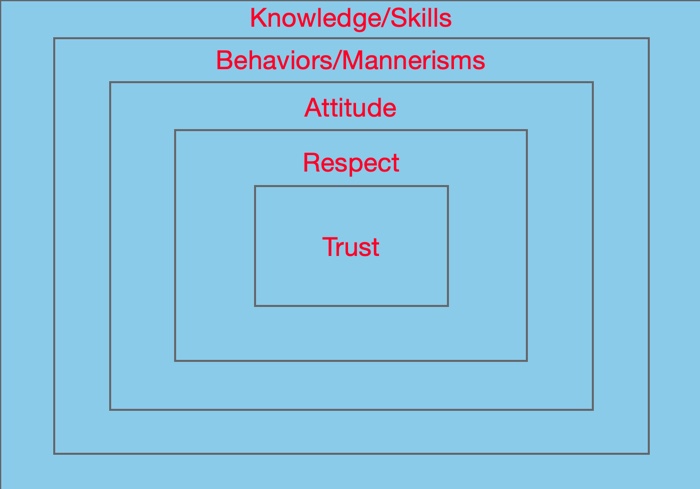
Figure 8. Smart Model
We've discovered that relationships also inspire the psychological understanding and self-awareness of each one of us. One model that we use is called the Smart Model and it begins with trust. We've discovered that if young children cannot trust, they are not going to respect. They're not going to have a positive attitude. They're not going to show appropriate behaviors and they will not learn within your program. We spend a lot of time developing trust, not only among young children but also between us and young children.
Will you choose to be the missing puzzle piece in your young children's lives? Every one of our young children needs to have somebody who is crazy about them, because they may not have that at home.
One strategy that we use is that everybody who is on our pay staff, whether it's the director, associate director, administrative assistant, cook, janitorial staff, or bus driver, is linked up with one of our young children. Every day that adult will greet and find out how that young child is doing and will write a positive note to that child and put it into our mailbox. Every day, each child will receive a positive note from an adult within our program. This is a great way to have every one of our children have somebody that's crazy about them.
Intervention
Why Adults Don't Always Intervene
- Have difficulty recognizing bullying
- Fail to recognize the importance of intervening
- Uncertain how best to intervene
- Lack of time
Now let's talk about intervention. There are a few reasons why adults don't intervene. First of all, they often don't know how to recognize bullying. The good news is that after this course, you will know the four criteria for bullying behavior. Second, many adults fail to recognize the importance of intervening. We've already discussed why it's important to intervene and prevent bullying behavior. Third, many adults don't know what to do. We're going to talk about specific steps and how to intervene. Last and most important, many adults feel that they do not have the time to intervene. After today's course, hopefully, you will understand why it's important to intervene with young children.
Steps to Intervene
- Intervene immediately
- Intervene even if you're not sure it's bullying
- Stand between or near the victim and the bully, separating them if necessary, so as to stop the bullying behaviors
- Respond firmly and describe the behavior you observed and why it is unacceptable
- Don’t ask children to “work things out” for themselves
- Impose consequences focusing on restitution
- Stick around
How do you intervene? First, stand between the bully and the young child who's being bullied. That immediately protects and more importantly, it stops the bullying behavior. Then respond firmly and describe the behavior you observed and why it is unacceptable within your program. For example, "Jimmy, I saw you push Andrew. That looked like bullying behavior. That behavior is not acceptable within our program. It goes against our guidelines of kindness."
It's extremely important that you do not ask children to work things out for themselves. I totally agree that conflict resolution is a very appropriate intervention strategy for young children with a number of behaviors, but it is not effective for bullying behavior. This is due to the imbalance of power that is present between the bully and the victim. Because of that imbalance of power, the bully will take over and control the situation and will actually re-victimize the other child.
With bullying behavior, you as an adult need to facilitate the intervention. There should be consequences, and the consequences imposed should be associated with restitution. Since you did something that was hurtful and harmful to your friend, now you have to do something that is going to help them. There are lots of different ways that you can implore restitution and consequences regarding bullying behavior into your program. After you intervene and use MIS strategies, stick around and make sure the behavior does not continue.
Follow-Up
- Keep a detailed record of the incident
- Inform appropriate staff
- Check-in regularly with the victim, the bully, and program staff
Promote Caring Behaviors
- Let children know that hurtful words or actions affect others
- Use demonstration, role-play, books and puppets to teach specific skills related to bullying
- Provide opportunities for children to work and play together
- Acknowledge caring behaviors
- A Big Guy Took My Ball!
- Billy the Bully
- No, David!
- The Bully From the Black Lagoon
- Marlene, Marlene, Queen of the Mean
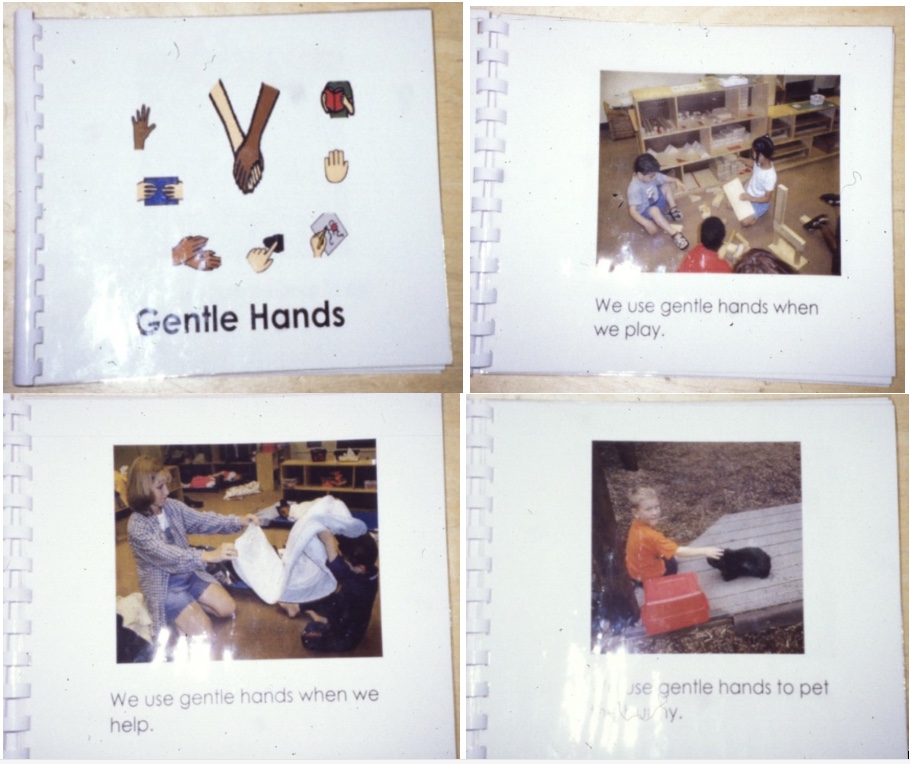
Figure 9. Gentle Hands modeling story.
We develop our own stories, and figure 9 shows an example of how to use our hands gently within our program. The first few pages of this book say, "We use gentle hands when we play. We use gentle hands when we help. We use gentle hands to pet the bunny." Most everyone has a digital camera connected to their phone. What a great way to make your own personalized books in order to help young children with bullying behavior.

Figure 10. Puppets.
We also like to use puppets, and we have lots and lots of puppets that we use. Figure 10 shows two of our puppets. We use these two puppets to address biting. Mr. Beaver has a huge tooth. How does it feel when Mr. Beaver bites you? We're talking and developing empathy as we use puppets. In addition, puppets and role-play are great ways to teach assertive behaviors. Assertive behaviors are a wonderful way to combat bullying because it allows young children to tell other children, "No, I don't like that." One of the ways to do that is through role play, puppets, and stories.
The last thing I want to mention is we like to help children engage in developing community within our programs. We have a lot of activities that promote togetherness and developing community within our early childhood program. For example, in our art area, we have buddy art where young children have to connect and work together in developing an artistic creation. We actually promote a lot of opportunities for young children to work together.
Shared Positive Class Activities
Have enjoyable and fun activities together. Some activities include:
- Gordion Knot
- Grapho
- Balloon Activity
- Clusters
Dealing with Bullies
- Nurture empathy
- Teach friendship skills
- Use non-violent discipline
- Intervene immediately with discipline
- Create opportunities to “do good”
- Teach socially acceptable behaviors
To foster a climate of cooperation and caring, host morning meetings. These should include a greeting, time for sharing, a group activity, and a message. For example,
My name is ____.
I teach ______.
A little know fact about me is _____.
(All) Good morning______.
Assertiveness
- Teach children to speak directly to each other, rather than through the teacher
- Teach children to say “No” politely and to accept “No” for an answer from others by saying “OK”
- Teach children to ignore routine provocative peer behaviors
- Use demonstration, role-play, books, and puppets to teach specific assertiveness skills related to bullying
- Teach children to use assertiveness skills to stand up to avoid submitting to bullying tactics
Factors Promoting Emotional Literacy
Emotional Skills
- Identifying and labeling feelings
- Managing feelings
- Expressing feelings
- Delaying gratification
- Assessing the intensity of feelings
- Controlling impulses
- Reducing stress
- Understanding others’ feelings
- Developing empathy
References
Anderson, M., Kaufman, J., Simon, T. R., Barrios, L., Paulozzi, L., Ryan, G., Hammond, R., Modzeleski, W., Feucht, T., Potter, L., and the School-Associated Violent Deaths Study Group. (2001). School-associated violent deaths in the United States, 1994-1999. Journal of the American Medical Association, 286, 2695-2702.
Atlas, R. S., & Pepler, D. J. (1998). Observations of bullying in the classroom. The Journal of Educational Research, 92, 86-99.
Boulton, J. J., & Smith, P. K. (1994). Bully-victim problems in middle-school children: Stability, self-perceived competence, peer perceptions and peer acceptance. British Journal of Developmental Psychology, 12, 315-329.
Boulton, M. J., & Underwood, K. (1992). Bully victim problems among middle school children. British Journal of Educational Psychology, 62, 73-87.
Byrne, B. J. (1994). Bullies and victims in school settings with reference to some Dublin schools. Irish Journal of Psychology, 15, 574-586.
Cairnes, R. B., Cairnes, B. D., Neckerman, H. J., Gest, S. D., & Gariepy, J. L. (1988). Social networks and aggressive behavior: Peer support or peer rejection? Developmental Psychology, 24, 815-823.
Charach, A. Pepler, D. J., & Zieler, S. (1995). Bullying at school: A Canadian perspective. Education Canada, 35, 12-18.
Chase, B. (March 25, 2001). Bullyproofing our schools: To eliminate bullying, first we must agree not to tolerate it. Editorial. www.nea.org/publiced/chase/bc010325.html
Cohen, R. (2002, February). Stop mediating these conflicts now! The School Mediator: Peer Mediation Insights from the Desk of Richard Cohen. Electronic newsletter, School Mediation Associates. www.schoolmediation.com/
Craig, W.M. (1998). The relationship among bullying, victimization, depression, anxiety, and aggression in elementary school children. Personality & Individual Differences, 24, 123-130.
Craig, W. M., & Pepler, D. J. (1997). Observations of bullying and victimization in the school yard. Canadian Journal of School Psychology, 13, 41-59.
Cunningham, P. B., Henggeler, S.W., Limber, S. P., Melton, G. B., and Nation, M. A. (2000). Patterns and correlates of gun ownership among nonmetropolitan and rural middle school students. Journal of Clinical Child Psychology, 29, 432-442.
Dawkins, J. L. (1996). Bullying, physical disability and the paediatric patient. Developmental Medicine and Child Neurology, 38, 603-612.
Dedman, B. (2000, October 15). School shooters: Secret Service findings. The Chicago Sun-Times.
Duncan, R. D. (1999). Peer and sibling aggression: An investigation of intra- and extrafamilial bullying. Journal of Interpersonal Violence, 14, 871-886.
Espelage, D., Bosworth, K., & Simon, T. (2000). Examining the social context of bullying behaviors in early adolescence. Journal of Counseling & Development, 78, 326-333.
Harris, S., Petrie, G., & Willoughby, W. (2002). Bullying among 9th graders: An exploratory study. NASSP Bulletin, 86 (630).
Haynie, D. L., Nansel, T., Eitel, P., Crump, A. D. Saylor, K., Yu, K., & Simons-Morton, B. (2001). Bullies, victims, and bully/victims: Distinct groups of at-risk youth. Journal of Early Adolescence, 21, 29-49.
Hodges, E. V. E., & Perry, D. G. (1996). Victims of peer abuse: An overview. Journal of Emotional and Behavioural Problems, 5, 23-28.
Hoover, J. H., Oliver, R., & Hazler, R. J. (1992). Bullying: Perceptions of adolescent victims in the Midwestern USA. School Psychology International, 13, 5-16.
Hugh-Jones, S., & Smith, P. K. (1999). Self-reports of short and long-term effects of bullying on children who stammer. British Journal of Educational Psychology, 69, 141-158.
Kochenderfer, B. J., & Ladd, G.W. (1996). Peer victimization: Cause or consequence of school maladjustment? Child Development, 67, 1305-1317.
Kumpulainen, K., & Räsänen, E. (2000). Children involved in bullying at elementary school age: Their psychiatric symptoms and deviance in adolescence. An epidemiological sample. Child Abuse and Neglect, 24, 1567-1577.
Kumpulainen, K., Rääsnen, E., & Puura, K. (2001). Psychiatric disorders and the use of mental health services among children involved in bullying. Aggressive Behavior, 27, 102- 110.
Loeber, R. & Dishion, T. (1983). Early predictors of male delinquency: A review. Psychological Bulletin, 94, 69-99.
Loeber, R., & Stouthamer-Loeber, M. (1986). Family factors as correlates and predictors of conduct problems and juvenile delinquency. In M. Tonry & N.Morris (Eds), Crime and Justice, Vol, 7. Chicago: University of Chicago Press.
Melton, G. B., Limber, S. P., Cunningham, P., Osgood, D.W., Chambers, J., Flerx, V., Henggeler, S., & Nation, M. (1998). Violence among rural youth. Final report to the Office of Juvenile Justice and Delinquency Prevention.
Metsähonkala, L., Sillanpää, M., & Tuominen, J., (1998). Social environment and headache in 8- to 9-year-old children: A follow-up study. Headache, 38, 222-228.
Mulvey, E. P. & Cauffman, E. (2001). The inherent limits of predicting school violence. American Psychologist, 56, 797-802. Educational Forum on Adolescent Health • Youth Bullying 15
Nansel, T. R., Overpeck, M., Pilla, R. S., Ruan, W. J., Simons Morton, B., & Scheidt, P. (2001). Bullying behavior among US youth: Prevalence and association with psychosocial adjustment. Journal of the American Medical Association, 285, 2094-2100.
Naylor, P., Cowie, H., & del Rey, R. (2001). Coping strategies of secondary school children in response to being bullied. Child Psychology & Psychiatry Review, 6, 114-120.
Olweus, D. (1978). Aggression in the schools: bullies and whipping boys.Washington, DC: Wiley.
Olweus, D. (1984). Aggressors and their victims: Bullying at school. In N. Frude & H. Gault (Eds.), Disruptive behavior in schools. New York: Wiley.
Olweus, D. (1991). Bully/victim problems among schoolchildren: Basic facts and effects of a school based intervention program. In D. J. Pepler and K. H. Rubin (Eds.), The development and treatment of childhood aggression (pp. 411-448).
Olweus, D. (1993a). Bullying at school: What we know and what we can do. NY: Blackwell.
Olweus, D. (1993b). Victimization by peers: Antecedents and long-term outcomes. In K. H. Rubin & J. B. Asendorf (Eds.), Social withdrawal, inhibition, and shyness (pp. 315- 341). Hillsdale, NJ: Erlbaum.
Olweus, D. (2001). Olweus’ core program against bullying and antisocial behavior: A teacher handbook. Bergen, Norway: Author.
Olweus, D., Limber, S., & Mihalic, S. (1999). The Bullying Prevention Program. Blueprints for Violence Prevention. Boulder, CO: Center for the Study and Prevention of Violence.
O’Moore, M., & Kirkham, C. (2001). Self-esteem and its relationship to bullying behaviour. Aggressive Behavior, 27, 269-283.
Perry, D. G., Kusel, S. J., & Perry, L. C. (1988). Victims of peer aggression. Developmental Psychology, 24, 807-814.
Rigby, K. (1996). Bullying in schools: And what to do about it. Bristol, PA: Jessica Kingsley Publishers.
Rigby, K. & Slee, P. T. (1991). Bullying among Australian school children: Reported behavior and attitudes toward victims. Journal of Social Psychology, 131, 615-627.
Rigby, K. & Slee, P. T. (1993). Dimensions of interpersonal relations among Australian school children and their implications for psychological well-being. Journal of Social Psychology, 133, 33-42.
Rivers, I., & Smith, P. K. (1994). Types of bullying behavior and their correlates. Aggressive Behavior, 20, 359-368.
Salmon, G., James, A., Cassidy, E. L., & Javoloyes, M. A. (2000). Bullying a review: Presentations to an adolescent psychiatric service and within a school for emotionally and behaviourally disturbed children. Clinical Child Psychology and Psychiatry, 5, 563- 579.
Shields, A. & Cicchetti, D. (2001). Parental maltreatment and emotion dysregulation as risk factors for bullying and victimization in middle childhood. Journal of Clinical Child Psychology, 30, 349-363.
Slee, P. T. (1995). Peer victimization and its relationship to depression among Australian primary school students. Personality and Individual Differences, 18, 57-62.
Slee, P. T., & Rigby, K. (1993). The relationship of Eysenck’s personality factors and self-esteem to bully-victim behaviour in Australian schoolboys. Personality and Individual Differences, 14, 371-373.
Smith, P. K., & Myron-Wilson, R. (1998). Parenting and school bullying. Clinical Child Psychology and Psychiatry, 3, 405-417.
Unnever, J. (2001). Roanoke city project on bullying. Final report of the Roanoke school-based partnership bullying study.
Whitney, I., & Smith, P. K. (1993). A survey of the nature and extent of bullying in junior/middle and secondary schools. Educational Research, 35, 3-25.
Yude, C., Goodman, R., & McConachie, H. (1998). Peer problems of children with hemiplegia in mainstream primary schools. Journal of Child Psychology and Psychiatry, 39, 533-541.16
American Medical Association Educational Forum on Adolescent Health • Youth Bullying 1718 American Medical Association
Citation
DeMeo, W. (2019). Bully Proofing Your Early Childhood Program, in partnership with Region 9 Head Start Association. continued.com - Early Childhood Education, Article 23399. Retrieved from www.continued.com/early-childhood-education
